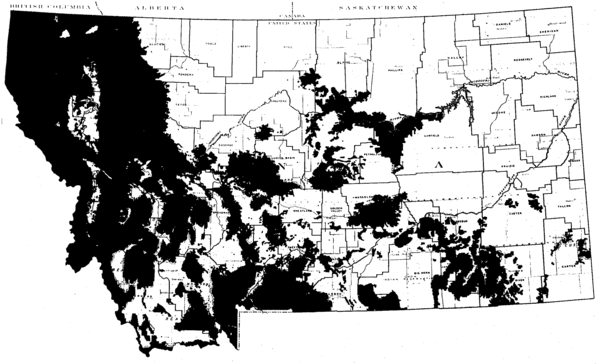
| HOME | SEARCH | ABOUT US | CONTACT US | HELP | ||
| |
| Rule: 36.10.101 | Prev Up Next | |
| Rule Title: CLASSIFICATION OF FOREST LANDS | ||
|
Add to Favorites |
||
| Department: | NATURAL RESOURCES AND CONSERVATION, DEPARTMENT OF | |
| Chapter: | FIRE MANAGEMENT | |
| Subchapter: | Fire Prevention on Forest Lands | |
| Latest version of the adopted rule presented in Administrative Rules of Montana (ARM): | ||
| Printer Friendly Version |
|
36.10.101 CLASSIFICATION OF FOREST LANDS (1) Forest lands for fire protection purposes is defined as any land which has in the judgement of the department a fire menace to life or property, provided that grassland and agricultural areas are included when such areas are intermingled with or contiguous to areas of forest land. The attached map indicates forest land areas in Montana for forest fire protection by the department. (2) Class I Land shall include all forest lands primarily suitable for production of timber and forest land primarily suitable for joint use for timber production and the grazing of livestock as a permanent or semi-permanent joint use or as a temporary joint use during the interim between logging and reforestation. (a) Detailed definition. Class I Forest Lands include: (i) lands which are at least 10% stocked by trees of any size and capable of producing timber or other wood products; (ii) land from which the trees described in (i) have been removed to less than 10% stocking but which have not been developed for other use; (iii) land not necessarily producing timber or other wood products, but 10% stocked with conifer trees and generally surrounded by land described in (i) and (ii) above. This land is not primarily suitable for grazing or other agricultural purposes; (iv) areas producing good individual trees strewn with boulders or cliffs restricting harvest of products, but the trees are in themselves commercial; or (v) cottonwood and other hardwood cover types only when adjacent to land described in (i) , (ii) , or (iii) above. (b) Detailed definition. Class II shall include: (i) lands primarily suitable for grazing, range lands, which are intermingled with or contiguous to Class I; (ii) lands primarily suitable for other agricultural purposes which are intermingled with or contiguous to Class I agricultural cropland only when the area is adjacent to Class I or intermingled therewith; (iii) lands primarily grazing but covered with cottonwood, intermingled with other Class II; (iv)gold-dredge lands; (v)alpine rock areas, bare rock and grass intermingled; or (vi) non-commercial forest land when this land area is producing scattered individual or groups of trees but not having the soil, water, weather, aspect, and other factors needed for growing usable sawtimber, i.e., short, scrubby slow growing, and few, if any, of the stems will make a sawlog. "Contiguous" includes land within one-half mile of Class I lands bounded by suitable road, stream, firebreak, or forty line. (4) Class 0 Land is other lands that do not meet the definitions of Class I and II lands. (Cottonwood and other hardwood when isolated from forest lands as defined above shall not in itself warrant a district) . Areas in which the concentration of residences and other buildings in the opinion of the administrator, DIVISION of forestry, makes the primary fire protection problem one of structural fires rather than forest fires will not be classified as forest land. For the purposes of this classification, a boundary shall be established eliminating the area from the district. � The black areas on this map indicate the forest land areas in Montana classified for forest fire protection by the State Forestry Board.� In addition to the federal ownerships, the classified areas include 12,527,469 acres of state land and privately owned lands. �
History: Sec. 76-13-109, MCA; IMP, Sec. 75-13-107, MCA; Eff. 12/31/72; TRANS, from Dept. of Nat. Res. , C. 529, L. 1981, Eff. 7/1/81; TRANS, 1995 MAR p. 1958, Eff. 7/1/95. |
| MAR Notices | Effective From | Effective To | History Notes |
|---|---|---|---|
| 7/1/1995 | Current | History: Sec. 76-13-109, MCA; IMP, Sec. 75-13-107, MCA; Eff. 12/31/72; TRANS, from Dept. of Nat. Res. , C. 529, L. 1981, Eff. 7/1/81; TRANS, 1995 MAR p. 1958, Eff. 7/1/95. |
A directory of state agencies is available online at http://www.mt.gov/govt/agencylisting.asp.
For questions about the organization of the ARM or this web site, contact [email protected].
